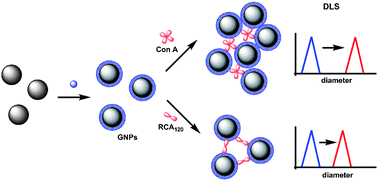Dynamic light scattering as an efficient tool to study glyconanoparticle–lectin interactions†
Abstract
Glyconanomaterials, an emerging class of bio-functional nanomaterials, have shown promise in detecting, imaging and targeting

* Corresponding authors
a
Department of Chemistry, Portland State University, P.O. Box 751, Portland, Oregon, USA
E-mail:
yanm@pdx.edu
Fax: +01 5037259525
Tel: +01 5037255756
b
Department of Chemistry, KTH - Royal Institute of Technology, Teknikringen 30, Stockholm, Sweden
E-mail:
ramstrom@kth.se
Fax: +46 87912333
Tel: +46 87906915
Glyconanomaterials, an emerging class of bio-functional nanomaterials, have shown promise in detecting, imaging and targeting

 Please wait while we load your content...
Something went wrong. Try again?
Please wait while we load your content...
Something went wrong. Try again?
X. Wang, O. Ramström and M. Yan, Analyst, 2011, 136, 4174 DOI: 10.1039/C1AN15469A
To request permission to reproduce material from this article, please go to the Copyright Clearance Center request page.
If you are an author contributing to an RSC publication, you do not need to request permission provided correct acknowledgement is given.
If you are the author of this article, you do not need to request permission to reproduce figures and diagrams provided correct acknowledgement is given. If you want to reproduce the whole article in a third-party publication (excluding your thesis/dissertation for which permission is not required) please go to the Copyright Clearance Center request page.
Read more about how to correctly acknowledge RSC content.
 Fetching data from CrossRef.
Fetching data from CrossRef.
This may take some time to load.
Loading related content
